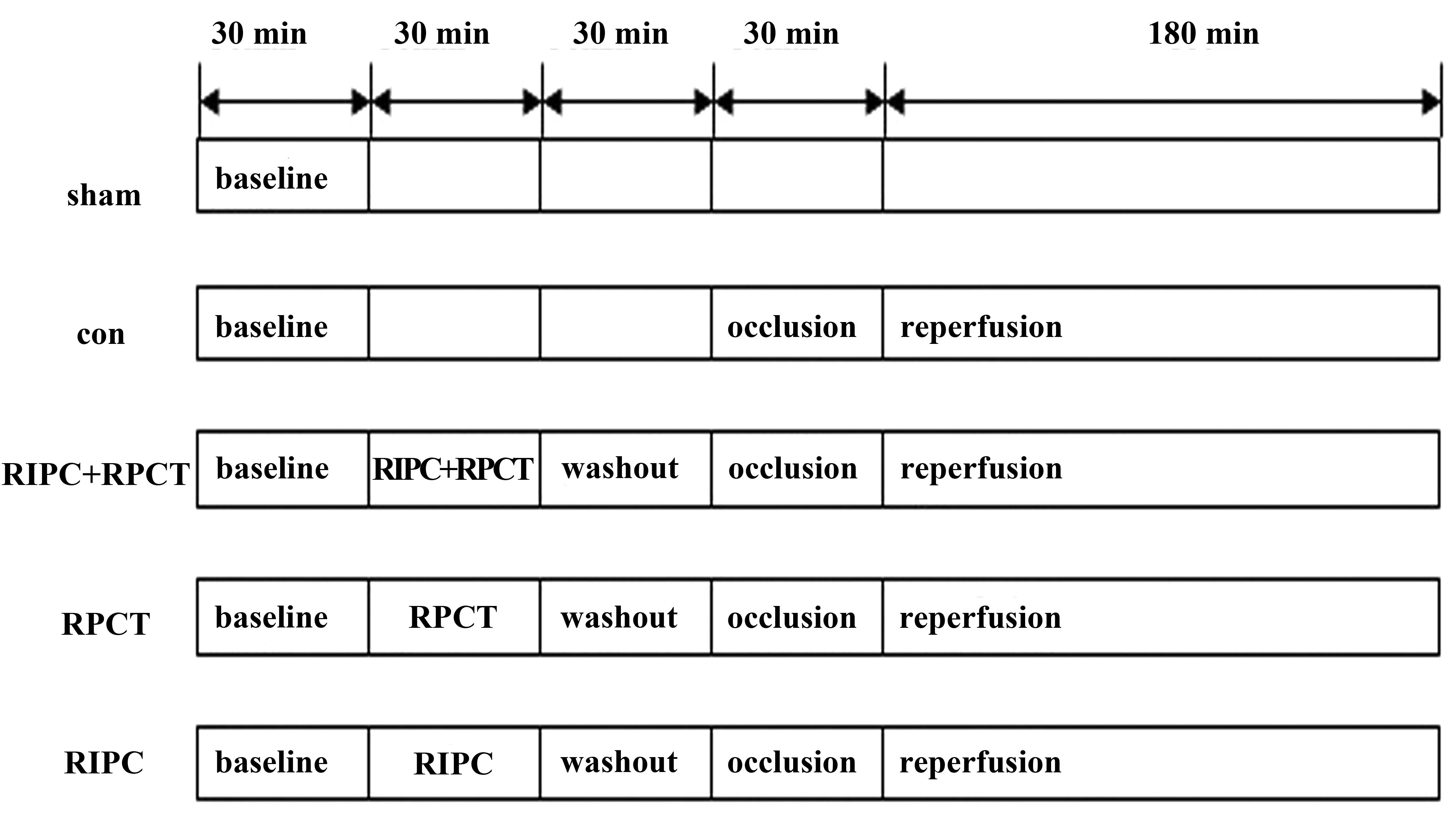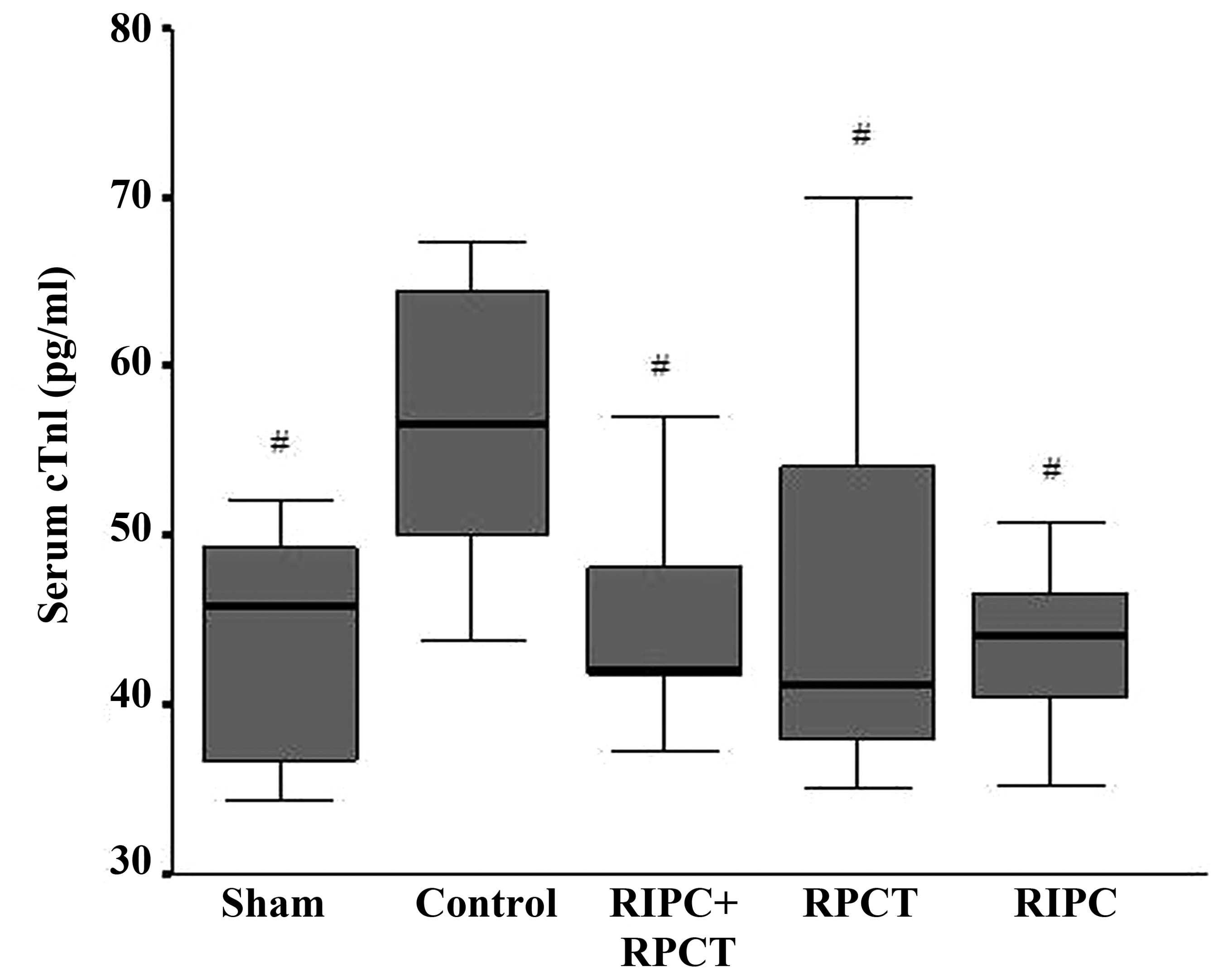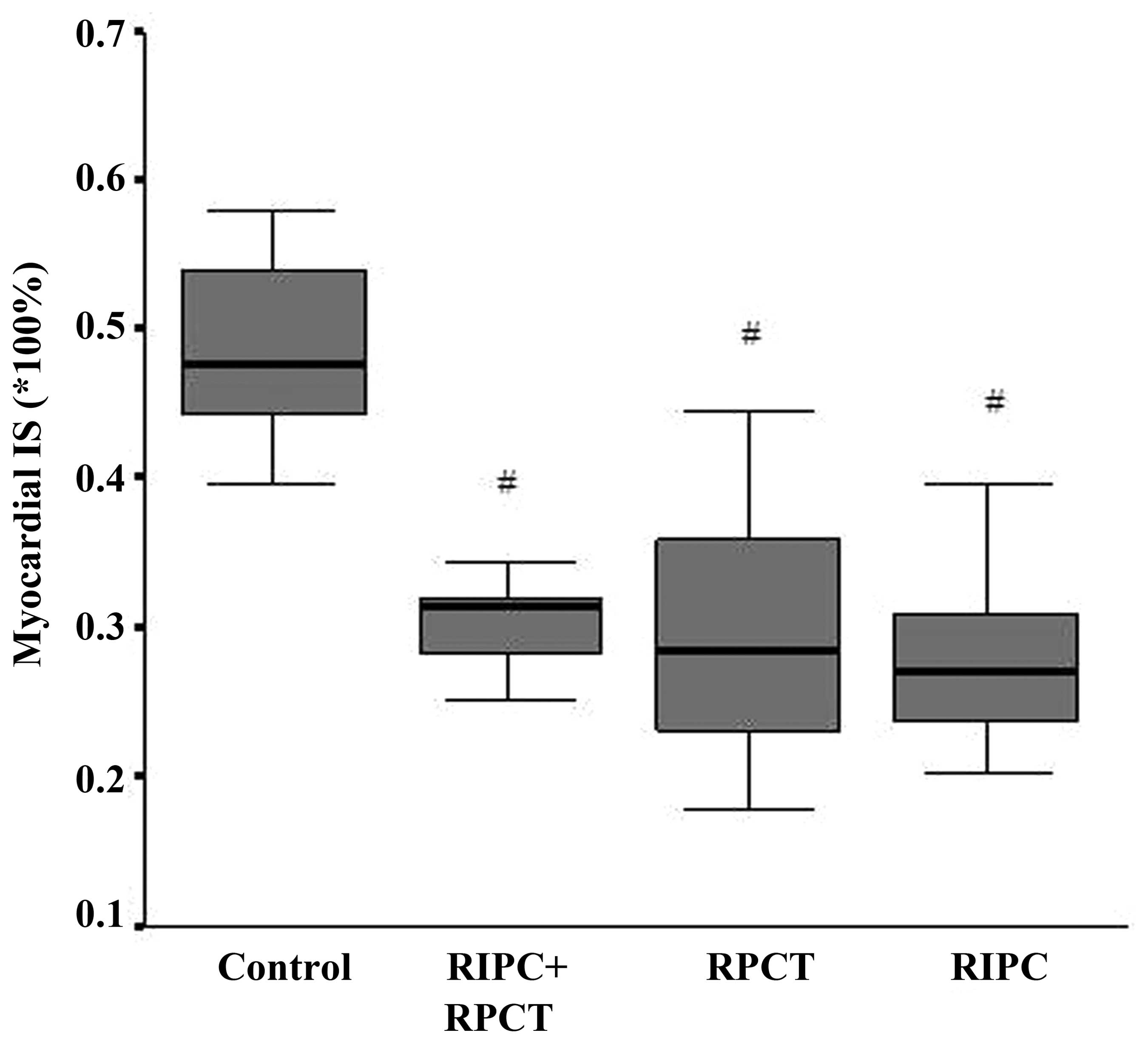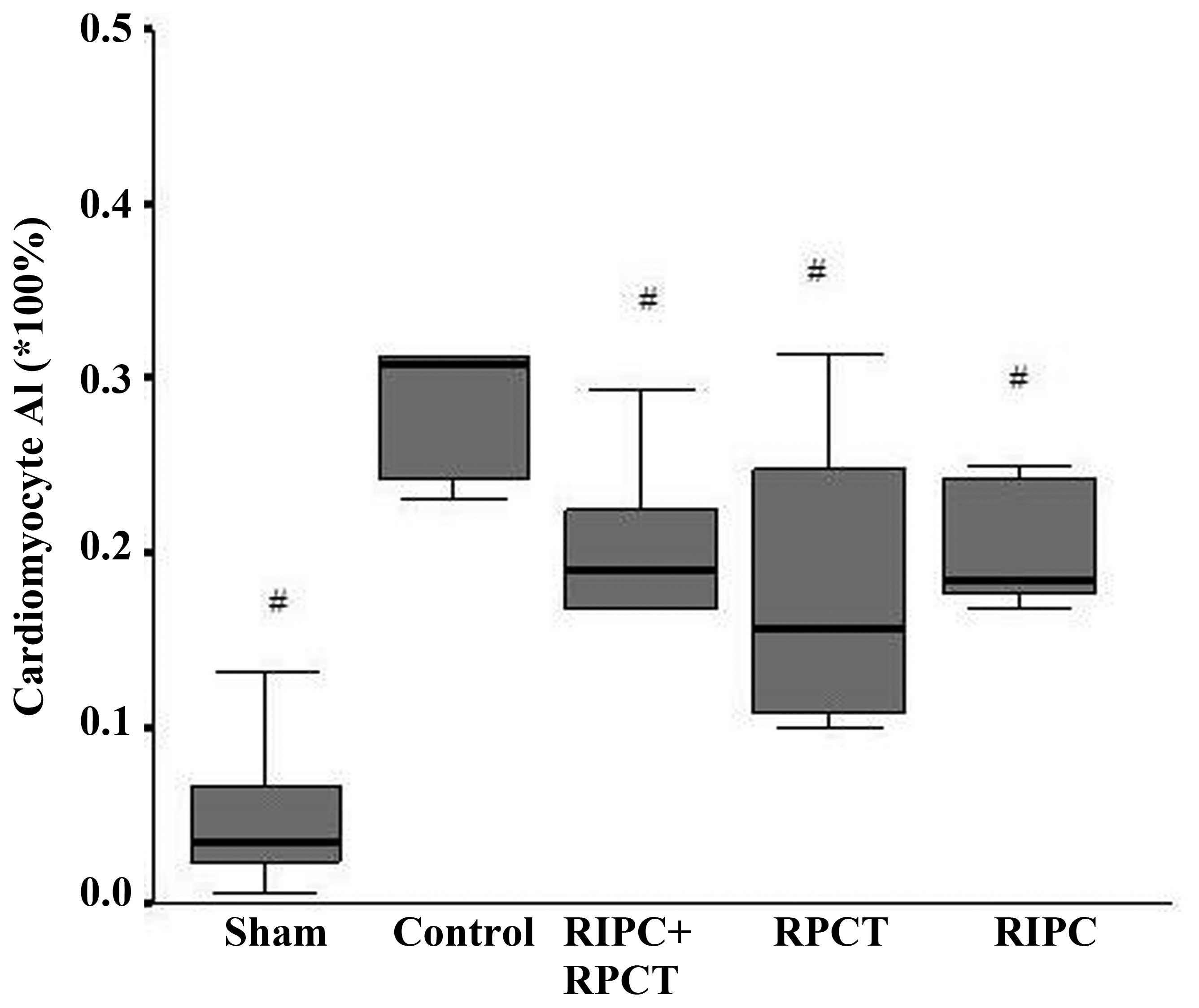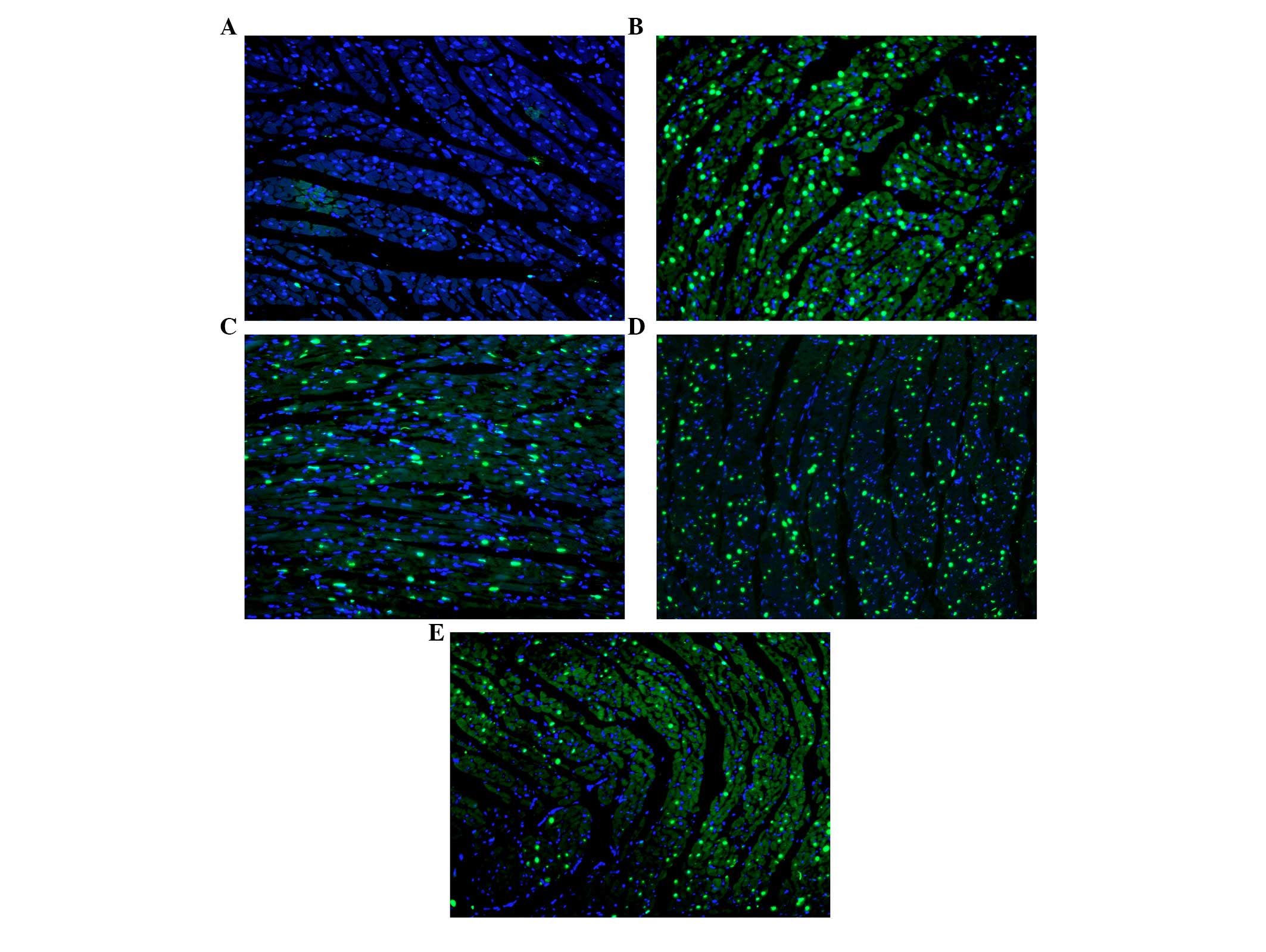Article
Cardioprotective effect of remote preconditioning of trauma and remote ischemia preconditioning in a rat model of myocardial ischemia/reperfusion injury
- Authors:
- Qing Chai
- Jin Liu
- Yang Hu
-
View Affiliations / Copyright
Affiliations:
Department of Critical Medicine and Anesthesiology, West China Hospital, Sichuan University, Chengdu, Sichuan 610041, P.R. China, Department of Thoracic and Cardiovascular Surgery, West China Hospital, Sichuan University, Chengdu, Sichuan 610041, P.R. China
-
Pages:
1745-1750
|
Published online on:
March 2, 2015
https://doi.org/10.3892/etm.2015.2320
- Expand metrics +
Metrics:
Total
Views: 0
(Spandidos Publications: | PMC Statistics:
)
Metrics:
Total PDF Downloads: 0
(Spandidos Publications: | PMC Statistics:
)
This article is mentioned in:
Abstract
Remote ischemia preconditioning (RIPC) and remote preconditioning of trauma (RPCT) are two methods used to induce a cardioprotective function against ischemia/reperfusion injury (IRI). However, the underlying mechanisms of these two methods differ. The aim of the present study was to investigate the cardioprotective function of the two methods, and also observe whether combining RIPC with RPCT enhanced the protective effect. In total, 70 male Sprague Dawley rats were randomly divided into five groups, which included the sham, control, RIPC + RPCT, RPCT and RIPC groups. With the exception of the sham group, all the rats were subjected to myocardial IRI through the application of 30 min occlusion of the left coronary artery and 180 min reperfusion. Serum cardiac troponin I (cTnI) levels, myocardial infarct size (IS) and the cardiomyocyte apoptotic index (AI) were assessed. The levels of serum cTnI were lower in the experimental groups when compared with the control group (control, 58.59±12.50 pg/ml; RIPC + RPCT, 46.05±8.62 pg/ml; RPCT, 45.98±11.24 pg/ml; RIPC, 43.46±5.05 pg/ml; P<0.05, vs. control), and similar results were observed for the myocardial IS (control, 48.34±6.79%; RIPC + RPCT, 29.64±4.51%; RPCT, 29.05±8.51%; RIPC, 27.72±6.27%; P<0.05, vs. control) and the AI (control, 31.75±10.65%; RIPC + RPCT, 18.32±9.30%; RPCT, 18.51±9.26%; RIPC, 20.41±3.86%; P<0.05, vs. control). However, no statistically significant differences were observed among the three experimental groups (P>0.05). Therefore, RIPC and RPCT exhibit cardioprotective effects when used alone or in combination. However, a combination of RIPC and RPCT does not enhance the cardioprotective effect observed with the application of either single method. Therefore, for patients undergoing major abdominal surgery, RIPC was considered to be unnecessary, while for patients undergoing other types of non‑cardiac major surgery and minimally invasive interventional surgery, RIPC may be useful. In addition, patients with embolism diseases are also liable to IRI when reperfusion treatment such as thrombolysis is conducted. Thus RIPC may also be beneficial for these patients.
View References
|
1
|
Yellon DM and Hausenloy DJ: Myocardial
reperfusion injury. N Engl J Med. 357:1121–1135. 2007. View Article : Google Scholar : PubMed/NCBI
|
|
2
|
Murry CE, Jennings RB and Reimer KA:
Preconditioning with ischemia: a delay of lethal cell injury in
ischemic myocardium. Circulation. 74:1124–1136. 1986. View Article : Google Scholar : PubMed/NCBI
|
|
3
|
Przyklenk K, Bauer B, Ovize M, Kloner RA
and Whittaker P: Regional ischemic ‘preconditioning’ protects
remote virgin myocardium from subsequent sustained coronary
occlusion. Circulation. 87:893–899. 1993. View Article : Google Scholar : PubMed/NCBI
|
|
4
|
Lim SY, Yellon DM and Hausenloy DJ: The
neural and humoral pathways in remote limb ischemic
preconditioning. Basic Res Cardiol. 105:651–655. 2010. View Article : Google Scholar : PubMed/NCBI
|
|
5
|
Kingma JG Jr, Simard D, Voisine P and
Rouleau JR: Role of the autonomic nervous system in
cardioprotection by remote preconditioning in
isoflurane-anaesthetized dogs. Cardiovasc Res. 89:384–391. 2011.
View Article : Google Scholar : PubMed/NCBI
|
|
6
|
Ren X, Wang Y and Jones WK: TNF-alpha is
required for late ischemic preconditioning but not for remote
preconditioning of trauma. J Surg Res. 121:120–129. 2004.
View Article : Google Scholar : PubMed/NCBI
|
|
7
|
Jones WK, Fan GC, Liao S, et al:
Peripheral nociception associated with surgical incision elicits
remote nonischemic cardioprotection via neurogenic activation of
protein kinase C signaling. Circulation. 120:(Suppl 11). S1–S9.
2009. View Article : Google Scholar : PubMed/NCBI
|
|
8
|
Xuan YT, Guo Y, Zhu Y, Wang OL, Rokosh G
and Bolli R: Endothelial nitric oxide synthase plays an obligatory
role in the late phase of ischemic preconditioning by activating
the protein kinase C epsilon p44/42 mitogen-activated protein
kinase pSer-signal transducers and activators of transcription1/3
pathway. Circulation. 116:535–544. 2007. View Article : Google Scholar : PubMed/NCBI
|
|
9
|
Wong GT, Ling Ling J and Irwin MG:
Activation of central opioid receptors induces cardioprotection
against ischemia-reperfusion injury. Anesth Analg. 111:24–28.
2010.PubMed/NCBI
|
|
10
|
Kanoria S, Jalan R, Seifalian AM, Williams
R and Davidson BR: Protocols and mechanisms for remote ischemic
preconditioning: a novel method for reducing ischemia reperfusion
injury. Transplantation. 84:445–458. 2007. View Article : Google Scholar : PubMed/NCBI
|
|
11
|
Sadat U: Signaling pathways of
cardioprotective ischemic preconditioning. Int J Surg. 7:490–498.
2009. View Article : Google Scholar : PubMed/NCBI
|
|
12
|
Das B and Sarkar C: Is preconditioning by
oxytocin administration mediated by iNOS and/or mitochondrial
K(ATP) channel activation in the in vivo anesthetized rabbit heart?
Life Sci. 90:763–769. 2012. View Article : Google Scholar : PubMed/NCBI
|
|
13
|
Gross GJ, Baker JE, Moore J, Falck JR and
Nithipatikom K: Abdominal surgical incision induces remote
preconditioning of trauma (RPCT) via activation of bradykinin
receptors (BK2R) and the cytochrome P450 epoxygenase pathway in
canine hearts. Cardiovasc Drugs Ther. 25:517–522. 2011. View Article : Google Scholar : PubMed/NCBI
|
|
14
|
Karuppasamy P, Chaubey S, Dew T, et al:
Remote intermittent ischemia before coronary artery bypass graft
surgery: a strategy to reduce injury and inflammation? Basic Res
Cardiol. 106:511–519. 2011. View Article : Google Scholar : PubMed/NCBI
|
|
15
|
Perrault LP, Menasché P, Bel A, et al:
Ischemic preconditioning in cardiac surgery: a word of caution. J
Thorac Cardiovasc Surg. 112:1378–1386. 1996. View Article : Google Scholar : PubMed/NCBI
|
|
16
|
Hoda MN, Siddiqui S, Herberg S, et al:
Remote ischemic perconditioning is effective alone and in
combination with intravenous tissue-type plasminogen activator in
murine model of embolic stroke. Stroke. 43:2794–2799. 2012.
View Article : Google Scholar : PubMed/NCBI
|















